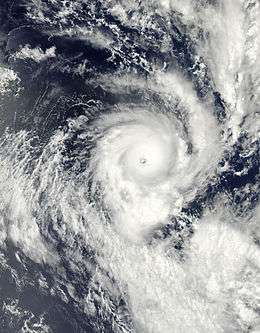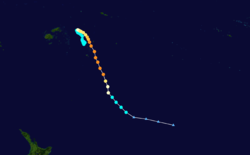Cyclone Ian
Cyclone Ian was a powerful tropical cyclone that formed on January 2, 2014. Areas affected by the tropical cyclone include Fiji and Tonga. In Tonga, Ian caused destruction in the Ha'apai islands, as well as one fatality.
| Category 5 severe tropical cyclone (Aus scale) | |
|---|---|
| Category 4 tropical cyclone (SSHWS) | |
 Cyclone Ian on January 11 | |
| Formed | January 2, 2014 |
| Dissipated | January 15, 2014 |
| (Extratropical after January 14) | |
| Highest winds | 10-minute sustained: 205 km/h (125 mph) 1-minute sustained: 240 km/h (150 mph) Gusts: 285 km/h (180 mph) |
| Lowest pressure | 930 hPa (mbar); 27.46 inHg |
| Fatalities | 1 direct |
| Damage | $48 million (2014 USD) |
| Areas affected | Fiji, Tonga |
| Part of the 2013–14 South Pacific cyclone season | |
Meteorological history

During January 2, 2014 the Fiji Meteorological Service's Regional Specialized Meteorological Center in Nadi, Fiji (RSMC Nadi) reported that Tropical Disturbance 07F had developed to the southeast of Futuna Island.[1] Over the next day the system gradually developed further underneath an upper level ridge of high pressure, within an area of moderate vertical wind shear, as it slowly moved towards the southwest.[1][2] RSMC Nadi subsequently classified the disturbance as a tropical depression early on January 4, as the systems low level circulation center consolidated.[3][4] Over the next day the system continued to move towards the southwest, before the United States Joint Typhoon Warning Center designated the system as Tropical Cyclone 07P late on January 5.[5] At around this time RSMC Nadi named the system Ian, after it had become a category 1 tropical cyclone on the Australian tropical cyclone intensity scale.[6]
Early on January 8, RSMC Nadi reported that Ian had become a category two tropical cyclone.[7] During that day the systems organization significantly improved with RSMC Nadi reporting at 1800 UTC that Ian had become a category three severe tropical cyclone.[8] Over the next day the system developed a cloud filled eye and intensified into a category 4 severe tropical cyclone. On January 12, as Ian started to weaken RSMC Nadi handed the primary warning responsibility, for issuing warnings over to the Wellington Tropical Cyclone Warning Center.
Preparations and impact

Late on January 10, a state of emergency was declared by Tongan Prime Minister Lord Tu'ivakano, after Ian intensified into a category five severe tropical cyclone[9] with 287 km/h winds. It struck the Ha'apai islands the next day between Tongatapu and Vava'u, according to the Director of Emergencies Leveni Aho. He also said that 23 islands that are a part of Ha'apai were unreachable by telephone and that patrol boats were traveling from island-to-island to get information. As a result of the cyclone, homes were flattened and at least one person was dead. Ha'apai governor Tu'i Ha'angana said that he was able to see from one side of the island to the other and "that's how devastated it is."[10] By 13 January, contact with the islands was restored.[11]
The electrical grid on Ha'apai sustained tremendous damage, with 90 percent of power lines being lost or severely damaged. Approximately 1,000 customers lost power during the storm. Estimates placed the cost to repair the system at NZ$4 million (US$3.5 million). By January 23, only 100 residences had power back and Tonga Power Limited (TPL) stated it could take a further two months to fully restore the system.[12] In addition to the severe disruption to power, 80–90 percent of the region's water supply was lost. Most residents in Ha'apai rely on rain water collection, and the collection tanks were largely destroyed by the storm.[13] The nation's tourism industry also experienced moderate to severe losses, with damage to facilities amounting to T$1.6 million (US$861,000).[14] Throughout the archipelago, 1,130 buildings were affected, half of which were completely destroyed. Of those structures not destroyed, 34 percent sustained major damage, including 13 schools. Approximately 2,300 people were left homeless by the storm.[15]
Total damage from the storm amounted to an estimated T$90.2 million (US$48 million).[16]
Aftermath
.jpg)
In the wake of Ian, the ANZ bank donated T$15,000 (US$8,000) to the Tonga Red Cross Society.[14] New Zealand provided NZ$2.27 million (US$1.87 million) in assistance to the TPL. In addition, six electricians, a front end loader, and a tractor were sent to assist in restoration and debris removal efforts.[17] Australia provided A$50,000 in emergency supplies including blankets, water containers, tarpaulins, kitchen sets and hygiene kits.[18] On January 22, the director of Tonga's National Emergency Office, Leveni Aho, announced that the scale of damage was beyond Tonga's ability to handle on its own and made a formal request for internal aid. Following this, China sent 400 tents to house displaced persons while France provided a cargo plane for supply transport.[13] In accordance with the FRANZ agreement, enacted in 1992, the Government of France established an air route from Nuku'alofa to Ha'apai and deployed an aircraft carrier from New Caledonia. The carrier, loaded with supplies from the French Red Cross, arrived in Tonga on January 17.[19] The Japanese Government provided 600 jerrycans and 30 water tanks (3,700 litre capacity), collectively worth ¥13 million (US$127,000).[20] Recovery from the cyclone is slow with over 80 families still living in tents over a year after the system had affected the islands.[21]
See also
References
- RSMC Nadi — Tropical Cyclone Centre (January 2, 2014). "Tropical Disturbance Summary January 2, 2014 21z". Fiji Meteorological Service. Archived from the original on January 3, 2014. Retrieved January 9, 2014.
- RSMC Nadi — Tropical Cyclone Centre (January 3, 2014). "Tropical Disturbance Summary January 3, 2014 21z". Fiji Meteorological Service. Archived from the original on January 3, 2014. Retrieved January 10, 2014.
- RSMC Nadi — Tropical Cyclone Centre (January 4, 2014). "Tropical Disturbance Summary January 4, 2014 06z". Fiji Meteorological Service. Archived from the original on January 4, 2014. Retrieved January 10, 2014.
- Joint Typhoon Warning Center (January 4, 2014). "Significant Tropical Weather Advisory for the Western and South Pacific Oceans January 4, 2014 12z". United States Navy, United States Air Force. Archived from the original on January 3, 2013. Retrieved January 10, 2014.
- Joint Typhoon Warning Center (January 5, 2014). "Tropical Cyclone 07P Tropical Cyclone Advisory January 5, 2014 21z". United States Navy, United States Air Force. Archived from the original on January 6, 2014. Retrieved January 10, 2014.
- RSMC Nadi — Tropical Cyclone Centre (January 5, 2014). "Tropical Disturbance Advisory January 5, 2014 21z". Fiji Meteorological Service. Archived from the original on January 6, 2014. Retrieved January 10, 2014.
- RSMC Nadi — Tropical Cyclone Centre (January 8, 2014). "Tropical Disturbance Advisory January 8, 2014 00z". Fiji Meteorological Service. Archived from the original on January 8, 2014. Retrieved January 12, 2014.
- RSMC Nadi — Tropical Cyclone Centre (January 8, 2014). "Tropical Disturbance Advisory January 8, 2014 18z". Fiji Meteorological Service. Archived from the original on January 9, 2014. Retrieved January 12, 2014.
- http://matangitonga.to/2014/01/11/state-emergency-declared-vava%E2%80%98u-and-ha%E2%80%98apai
- http://www.aljazeera.com/news/asia-pacific/2014/01/powerful-cyclone-rips-through-tonga-islands-201411264930152149.html
- http://www.abc.net.au/news/2014-01-13/an-tonga-monday/5196822
- "US$3.5 million and two months to restore Ha'apai's power". Dateline Pacific. Radio New Zealand International. January 23, 2014. Archived from the original on January 26, 2014. Retrieved January 26, 2014.
- "Cyclone Ian: Tonga appeals for international help in relief efforts". Australian Broadcasting Corporation. January 22, 2014. Archived from the original on January 26, 2014. Retrieved January 26, 2014.
- "Tonga's Tourism Ministry estimates $1.6m damage to Ha'apai tourism facilities". Matangi Tonga. Islands Business. January 20, 2014. Archived from the original on January 26, 2014. Retrieved January 26, 2014.
- "Tonga asks for more NZ help in Cyclone Ian aftermath". ONE News. Television New Zealand Limited. January 17, 2014. Archived from the original on January 26, 2014. Retrieved January 26, 2014.
- January 2014 Global Catastrophe Recap (PDF) (Report). AON Benfield. 2014. Retrieved December 23, 2014.
- "NZ linesmen to help restore Tongan power". Australian Associated Press. MSN New Zealand. January 25, 2014. Archived from the original on January 26, 2014. Retrieved January 26, 2014.
- "Australia responds to Cyclone Ian in Tonga". Australian Government. January 14, 2014.
- "Aide française au profit des populations sinistrées des Ha'apai après le passage du cyclone Ian (Tonga, 11-12 janvier 2014)". Government of France (in French). ReliefWeb. January 23, 2014. Retrieved January 26, 2014.
- "Japan Handed Over Emergency Assistance for Cyclone Disaster". Government of Japan. ReliefWeb. January 24, 2014. Retrieved January 26, 2014.
- http://www.radionz.co.nz/international/pacific-news/266284/new-houses-for-tongan-cyclone-victims
